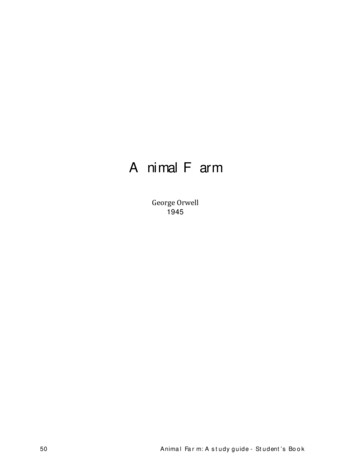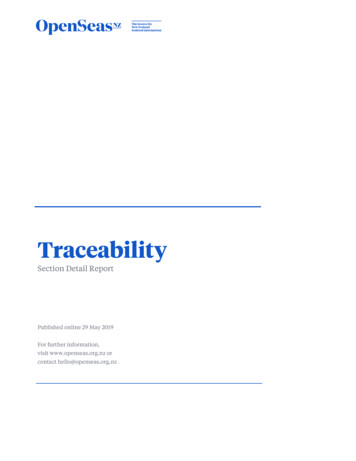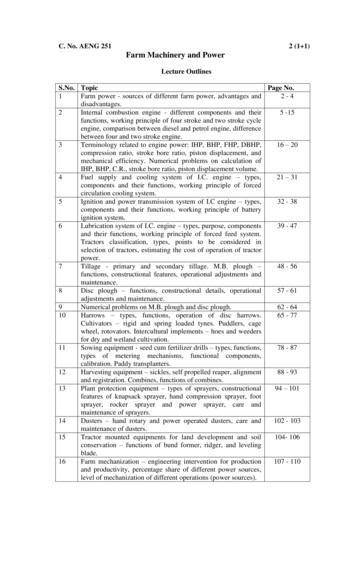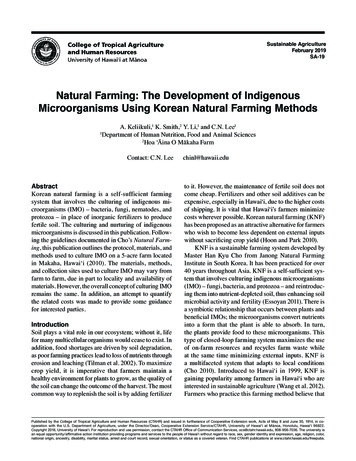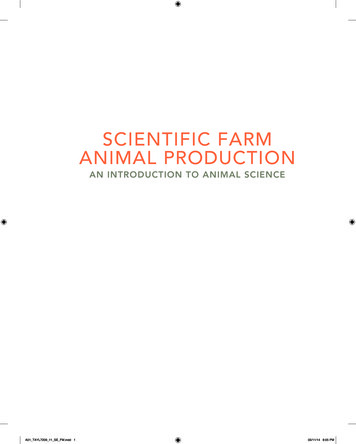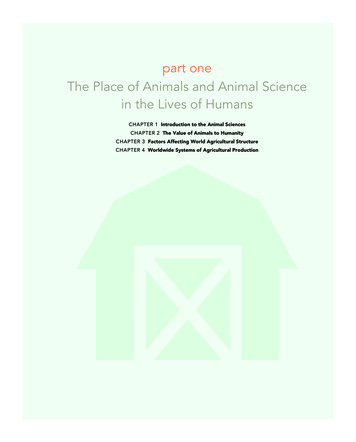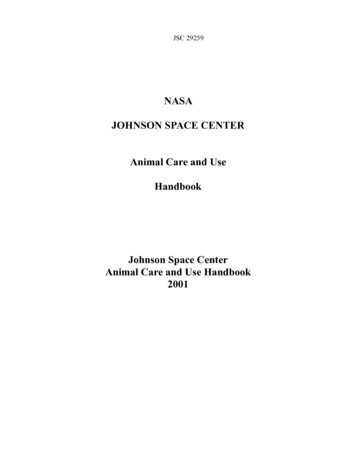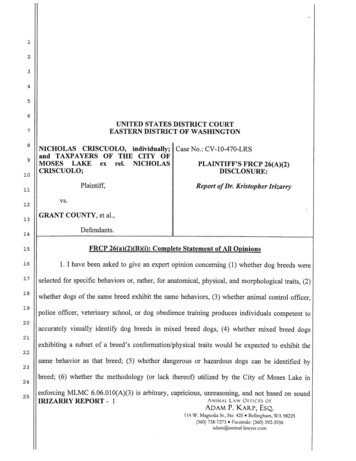
Transcription
Kristopher J. L. Irizarry, Ph.D.CURRICULUM VITAEkirizarry@westernu.edu309 E. Second StreetPomona, California 91766-1854Updated: March 2011EDUCATION:B.S. Biochemistry & Biophysics, 1996Renselaer Polytechnic Institute, Troy New YorkPh.D. Biochemistry & Molecular Biology, 2003Dissertation Title “Identification and Analysis of Single Nucleotide Polymorphisms in the CodingRegions of the Human Genome” University California, Los AngelesPostdoctoral Fellowship UCLA Center for PharmacogenomicsPharmacogenomics of Antidepressant Treatment ResponseNeuropsychiatric Institute, David Geffen School of Medicine at UCLAPROFESSIONAL EXPERIENCE:2006 - present Assistant Professor, Bioinformatics, Genetics & GenomicsCollege of Veterinary MedicineWestern University of Health SciencesPomona, California2004-2005Lecturer / ResearcherNeuropsychiatric Institute (NPI)University California, Los Angeles, CA2003- 2004Postdoctoral Fellowship Neuropsychiatric Institute (NPI),University of California, Los Angeles, CA.2000Teaching Assistant: Biochemistry and Molecular BiologyUniversity California, Los Angeles, CA1998-1999Teaching Assistant: Molecular, Cellular, and Developmental BiologyUniversity of California, Los Angeles, CA1998-2003Graduate Student, Laboratory of Bioinformatics & Structural Genomics,University of California, Los Angeles, CA.1997Bioinformatics Research InternshipIncyte PharmaceuticalsPalo Alto, CA1995-96Research Assistant, Center for Biophysics,Rensselaer Polytechnic Institute, Troy NY1995Summer Research Position, NINDS/National Institutes of Health, Bethesda, MD1994-95Research Assistant, Addictions Laboratory, RPI, Troy, NY
PROFESSIONAL ACTIVITIES:California Veterinary Medicine Association – faculty membershipEvidence Based Veterinary Medicine Association – charter membershipCalifornia Science Fair – Judges Advisory CommitteeAdvisor – Genetics, National Canine Research CouncilCoordinator – Western University Students Research and Technology Symposium (STARS)HONORS AND AWARDS:2003 – 2004NIH T32 Psychobiology Postdoctoral Fellowship2000 - 2003NSF Integrative Graduate Education and Research Traineeship1998 - 2000NIH Biotechnology Training Grant1994 - 1996Rensselaer ScholarshipRESEARCH FUNDING:9/1/08-12/30/11Research Contract 19,000PI: K. IrizarryHills Pet Nutrition“Nutrigenomics: comparative genomics analysis of novel gene sequences”1/1/09 - 12/31/11USDA 325,000“Impact of immune responses of chickens with defined B haplotypes on resistance to respiratoryinfection” PI: Ellen Collisson, Yvonne Drechsler, Co-investigators: K. Irizarry, M Saggese10/2009-9/2011Institute of Museum and Library Services 100,000“Correlation of Snow Leopard Genetics with Immune Function: A Model for the Integration ofFunctional Genomics into Endangered Species Captive Breeding Plans.”IMLS Collaborative Planning GrantProject Director: Margaret C. Barr; Co-PIs: Kristopher Irizarry, Janis Joslin, CollaboratorsTodd Mockler, Jay Tetzloff1/1/07-12/30/08Research Subcontract 20,000PI: K. IrizarryCenter for Neuroeconomic Studies, Claremont Graduate University“Analysis of genes associated with behavioral and neuroeconomic phenotypes in humans”7/1/07Anonymous Giftvalue: 15,000PI: K. Irizarryhardware donation“Computational Infrastructure for cluster computing genomics applications”7/1/2007-6/30/08Intramural Research Grant 15,000PI: K. IrizarryWestern University of Health Sciences“Identification and analysis of genes underlying behavioral phenotypes: combiningbioinformatics, comparative genomics and sequencing to accelerate discovery in the caninegenome”9/30/02-9/29/07NIDDK/NIH 80,000PI: Julio Licinio, M.D.R01 DK063240Co-investigator: Kris Irizarry, Ph.D., awarded a minority supplement for this project."Depression and Metabolic Syndrome in Mexican-American Women"09/28/04-07/31/07NCRR/NIHPI: Robert M. Bilder1P20RR020750Co-investigator: Kris Irizarry, Ph.D"Cognitive Phenotyping for Neuropsychiatric Therapeutics" 42,000
09/30/83-06/30/08NIMH/NIHPI: Andrew F. Leuchter5T32MH017140-20Post-doctoral fellow: Kris Irizarry, Ph.D."Research Training: Psychological Sciences" 33,000LECTURES & PRESENTATIONS & POSTERS:Kristopher Irizarry “Comparative Mammalian Phenomics” Guest Lecturer at Oregon StateUniversity Graduate Course in Genomics. March 4th and March 7th, 2011Katherine MItsouras, Erica A. Faulhaber, Gordon Hui, Kristopher J. L. Irizarry. “Developmentof a PCR-assay to detect papillomavirus in the snow leopard.” Plant and Animal GenomicsMeeting. San Diego, California, January 15-19, 2011V. Voith,C. Chadik, E. Ingram, K. Irizarry, K. Mitsouras, J. Marilo. “Dog BreedIdentification”. American College of Veterinary Behaviorists and The AmericanVeterinary Society of Animal Behaviorists Atlanta, Georgia, 2010Hui, Erica Faulhaber, Aleli Camacho, Katherine MItsouras, Kristopher Irizarry. “Constructionof a Comparative Genomics Map To Facilitate The Annotation Of The Draft Snow LeopardGenome”. Merial Veterinary Scholoar's Symposium, Athens, Georgia, August 2010.Kristopher Irizarry “How to facilitate student use of published and online resources duringcreation of science projects” Presentation for Mentors of California Science Fair Students,California Science Fair May 2010.Katherine Mitsouras, Gabrielle Galgoul, Audrey Hoholm, Cheng Li, KristopherIrizarry “Using bioinformatics and comparative genomics to map cancer associatedphenotypes to the canine genome.” Genes, Dogs & Cancer: 5th International CanineCancer Conference February 13 – 15, 2009, Orlando Florida (submitted abstract wasaccepted for poster presentation in February 2009)Irizarry, Kristopher “"The great debate - Does behavioral genetics imply behavior isdeterministic? Reflections on free will, determinism and the contributions of nature and nurtureto animal behavior" Western University College of Veterinary Medicine Behavior Club – InvitedTalk – November 2008.Irizarry, Kristopher “Developing novel comparative genomics based phenotype annotation foruse in the publicly available gene expression analysis software package DChip” Department ofBiostatistics and Computational Biology, Dana Farber Cancer Institute, Harvard University,Boston MA, Oct. 29, 2008.Irizarry, Kristopher “Bioinformatics and Comparative Genomics Approaches for AnnotatingThe Chicken Genome” USDA Multistate Immunogenetics Research Poultry Meeting, October 162008, Washington DC.Irizarry, Kristopher “Leveraging Comparative Genomics to Infer-FunctionalConsequences of Gene Expression Changes: Accelerating Microarray Discovery viaPhenomics Annotation” Cambridge Healthtech’s Eigth Annual Integrative Data AnalysisConference, Providence Rhode Island, Sept. 24, 2008
V. Voith & Irizarry, K “Dog Breed Identification Quiz and DNA results” Orange BeltVeterinary Medical Association, Riverside CA - September 16, 2008Irizarry K “Decoding Dog DNA: finding physiology and pathology in the caninegenome” Western University of Health Sciences Research Seminar: Pomona, CaliforniaAugust 27, 2008Irizarry, Kristopher “An introduction to the genetics of behavior” Charles DrewUniversity, Los Angeles California, August 12, 2008.Irizarry, Kristopher “Comparative Genomics: From Mice to Men and Dogs” Western/DrewResearch Retreat at the California Endowment Center for Healthy Communities in LosAngeles. July 15, 2008.Irizarry, KJ “Managing a collaborative Problem-Based Learning Curriculum” LillyWest SoTL Conference, Pomona California, March 22, 2008Irizarry K “Understanding canine genetics as it relates to dog breeds and behavior”Invited Talk for The Farm Animal Foundation, New York, Oct. 2007Irizarry KJL, Day A, Mitsouras K, Lee CJ, Wong ML, Licinio J. “Novel Strategies forPsychiatric Pharmacogenomics” Pharmacogenetics Research and Knowledge BaseFourth Scientific Meeting Los Angeles, California March 8, 2004.Irizarry K, Day, A, Mitsouras K, Lee C, Wong ML, Licinio J. “Identification and Integrationof Diverse Genomic Signals: Building Neuroinformatics Tools for PharmacogenomicsApplications” International Society of Pharmacogenomics Meeting LA, CA Nov. 2003.Irizarry K, Day, A, Mitsouras K, Lee C, Licinio J. “Identifying candidate SNPs for highthroughput pharmacogenomics studies of CNS disorders” International Pharmacogenomics JointCold Spring Harbor Laboratory/Wellcome Trust Conference, Hinxton UK Sep. 25, 2003Irizarry, K, Galbraith, S, Miller, D, Lee, C. “Genomic SNP Mapping” Lake Tahoe Symposia onMolecular Diversity, January 29 - February 2, 2001Lin, XJ, Irizarry, K., Lengyel, JA "Drosophila Arc, a novel membrane associated PDZ domainprotein is involved in epithelial morphogenesis" 39th Annual Drosophila Research ConferenceWashington D.C. March, 1998Chambers, M. D., Irizarry, K. L., Boswell, K. J., Hubbell, C. L., & Reid, L. D., “A SelectiveOpioid Antagonist Block’s Cocaine’s Rewarding Effects” Presented at the AmericanPsychological Association Annual Conference, New York, New York, August 1995.PAPERS - IN REVIEW / PREPARATIONKristopher J. L. Irizarry, Sukhaswami Malladi, Xiangming Gao, Katherine MItsouras,Lynda Melendez, Patricia Burris, Jeffrey Brockman, Samer Al-Murrani."Sequencing and Comparative Genomic Analysis of 1227 Felis catus cDNASequences Enriched for Developmental, Clinical and Nutritional Phenotypes"
manuscript in preparation, anticipated submission for Genome Biology date:April 15 2011.Katherine Mitsouras, Erica Faulhaber, Gordon Hui, Janis Joslin, Curtis Eng, Margaret C.Barr, Kristopher J. L. Irizarry "Development of a PCR Assay to DetectPapillomavirus Infection in the Snow Leopad" BMC Veterinary Research,submitted Jan. 26, 2011, under reviewPAPERS – PEER REVIEWEDLiao G, Wen Z, Irizarry K, Huang Y, Mitsouras K, Darmani M, Leon T, Shi L, Bi X. Abnormalgene expression in cerebellum of Npc1-/- mice during postnatal development.Brain Res.2010 Apr 14;1325:128-40.Voith VL, Ingram E, Mitsouras K, Irizarry K. Comparison of adoption agency breedidentification and DNA breed identification of dogs. J Appl Anim Welf Sci. 2009Jul;12(3):253-62.John David and Kristopher Irizarry “Using the PubMatrix literature mining resource toaccelerate student-centered learning in a veterinary PBL curriculum” Journal ofVeterinary Medical Education, 2009 Summer;36(2):202-8.Irizarry K, Merriman B, Bahamonde M, Wong M-L, Licinio J. The evolution of signalingcomplexity suggests a mechanism for reducing the genomic search space in humanassociation studies. Molecular Psychiatry 2005 AOP doi:10.1038/sj.mp.4001576.Wong M-L, O'Kirwan F, Hannestad JP, Irizarry KJL, Elashoff D, Licinio J. “St. John's wortand imipramine-induced gene expression profiles identify cellular functions relevant toantidepressant action and novel pharmacogenetic candidates for the phenotype ofantidepressant treatment response”. Molecular Psychiatry 2004; 9:237-251.Licinio J, O'Kirwan F, Irizarry K, Merriman B, Thakur S, Jepson R, Lake S, Tantisira KG,Weiss ST, Wong M-L. “Association of a corticotropin-releasing hormone receptor 1haploytype and antidepressant treatment response in Mexican Americans”. MolecularPsychiatry 2004 AOP doi:10.1039/sj.mp.4001587Irizarry, K., Hu, G., Wong, M-L., Licinio, J., Lee., CJ “Single Nucleotide PolymorphismIdentification in Candidate Gene Systems of Obesity” The Pharmacogenomics Journal1(3):193-203, 2001.Lee, C. and Irizarry, K. “The GeneMine System for Genome Proteome Annotation andCollaborative Data Mining” IBM Systems Journal 40(2) 592-603 2001.Irizarry, K., Kustanovich, V., Cheng, L., Brown, N., Nelson, S., Wong, W., Lee, C.J.“Genome Wide Analysis of Single Nucleotide Polymorphisms in Human ExpressedSequences” Nature Genetics 26: 233-236, 2000.Salerno, J.C., Harris, D.E., Irizarry, K., Patel, B., Morales, A.J., Smith, S.M.E., Jones, C.,Weissman, B.A., Liu, Q., and Gross, S.S. “The autoinhibitory control element definescalcium regulated isoforms of nitric oxide synthase” Journal of Biological Chemistry272 (47) :29769 -29777 Nov. 1997
Reid, Larry D., Hubbell, Christopher L., Glick, Stanley D., Boswell, Karen J., Chen, Alice M,Moran, Catherine M., Cramer, Christopher M., Mullen, Ursula D., Chambers, MichaelD., Gonzales, Patricia M., Irizarry, Kristopher L., and Amendola, Christopher A.,“Initial Analysis of Naltriben, a Delta Opioid Antagonist, As a Putative Medicine forTreating Cocaine Abuse.” Experimental and Clinical Psychopharmacology 4, 271-284,1996.NON-PEER REVIWED PAPERSIrizarry KJ, Licinio J. “An explanation for the placebo effect?” Science March 307 (5714) 2005.Irizarry KJ, Galbraith SJ. “Significance of SNP combination patterns” Molecular Psychiatry9(5):430 2004.Irizarry KJ, Galbraith SJ. “Complex disorders reloaded: causality, action, reaction, causeand effect.” Molecular Psychiatry, 9(5):431-2 2004.Lee, CJ, Irizarry, K., “Alternative Splicing in the Nervous System: An Emerging Source ofDiversity and Regulation” Biological Psychiatry 54(8):771-6 2003.BOOK CHAPTERS:Kristopher J. L. Irizarry “Bioinformatics approaches for identifying allelic variants incandidate pathways underlying major depression and antidepressant treatment response” Biologyof Depression Wiley-VCH Verlag GmbH & Co. KgaA, Weinheim Germany 901-942 copyright2005.PATENTSLiciniuo, Julio; Wong, Ma-Li; Irizarry, Kristopher, J., L.; Irizarry, Katherine,Misouras. “Compositions and methods for determining and predicting treatmentresponses for depression and anxiety” PCT/US2005/028790, PublicationDate:16.02.2006 International Filing Date:12.08.2005
Summary of Points (Pt.1) Domesticated dogs were bred for specificmorphological and anatomical traits The breed‐associated anatomical traits areencoded by a very small number of genes (19,000genes in dog genome, 6 control head shape) Tens of thousands of genes are responsible forwiring the mammalian brain and contributing toits function and the behavior of an organism
Summary of Points (Pt.2) Identifying anatomical features such as headshape, coat length, coat color, body size,musculature only indicate that the genetic signalsencoding those traits are contained in a dog’sgenome There is no scientific basis for assuming thatshared anatomical features among dogscorrelates with shared brain organization orbehavior – in fact there is very strong scientific,genetic and neuroscience evidence against thisview
Summary of Points (Pt.3) Breeds were designed to conform to a physicalbreed standard. Subsequently, the stratificationof dog breeds resulted in breed members sharingkey anatomical / morphological traits. The genetic basis for the sharing of theseanatomical traits is well described by researchersfrom MIT and Harvard and NIH who havesystematically sequenced the dog genome anddetermined that roughly 50 genes are responsiblefor breed associated differences in appearance
Summary of Points (Pt.4) Dogs visually identified as dangerous breeds are identifiedon the basis of specific anatomical traits that are encodedby a handful of genes The genes associated with morphological traits of dogsvisually identified as dangerous dogs are not involved in thedevelopment, wiring, organization or function of the dog’sbrain Recent studies have identified over 17,000 genes withinhundreds of anatomical regions of the mammalian brain.This complex organ and molecular system can not beinferred from tens of genes encoding head shape, snoutlength, body size and coat color/texture
Summary of Points (Pt.5) The accurate identification of breeds withinmixed breed dogs is impossible because only50 or so genes out of almost 20,000 genes inthe dog genome control the external physicalappearance of domestic dogs. 50 genes / 20,000 genes 0.25% LESS THAN 1% OF THE DOG’S GENOMEENCODES IT’S BREED ASSOCIATED PHYSICALTRAITS
Summary of Points (Pt.6) The notion that one can infer dangerous neurologicalstructures in a mammalian brain OR dangerous motivationson the basis of anatomical traits is not rational for threereasons: 1. The genes encoding the anatomical traits do not encodethe brain traits 2. The presence of anatomical traits provides absolutely noinference about genes encoding behavioral traits 3. Phrenology, the practice of inferring human personalitytraits from the shape of the skull was debunked at the turnof the 20th century and should not be the basis of 21stcentury laws
Phrenology was an attempt to infer personality traits from surface properties of the head
Offspring derive half of their DNA fromeach parent.XThe reproductive cross of two differentpure breeds will result in a dog thatcontains 50% of the DNA from eachancestral breed.The offspring of this cross is NOT amember of either of the parentalbreeds as it lacks 50% of each parentalbreeds’ DNA.
XXXA dog that is only 25% of a specific breedlacks 75% of the genome from that breed.Such a dog is much more geneticallysimilar to “dogs in general” than it is toone of its ancestral breeds.
XAll five puppies in the litter have the same mixed breed proportionsbut each puppy has a distinctly unique genome derived from ancestors50%12.5%12.5%12.5%12.5%
“Nutrigenomics: comparative genomics analysis of novel gene sequences” 1/1/09 - 12/31/11 USDA 325,000 . Irizarry K “Understanding canine genetics as it relates to dog breeds and beh

